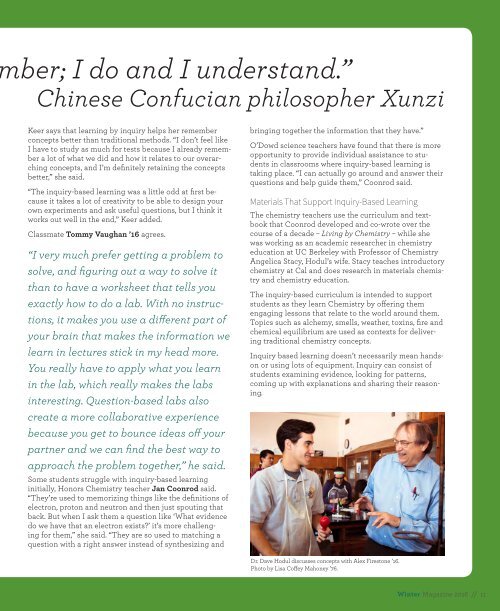Winter 2016
2016 winter dragon
2016 winter dragon
Create successful ePaper yourself
Turn your PDF publications into a flip-book with our unique Google optimized e-Paper software.
mber; I do and I understand.”<br />
Chinese Confucian philosopher Xunzi<br />
Keer says that learning by inquiry helps her remember<br />
concepts better than traditional methods. “I don’t feel like<br />
I have to study as much for tests because I already remember<br />
a lot of what we did and how it relates to our overarching<br />
concepts, and I’m definitely retaining the concepts<br />
better,” she said.<br />
“The inquiry-based learning was a little odd at first because<br />
it takes a lot of creativity to be able to design your<br />
own experiments and ask useful questions, but I think it<br />
works out well in the end,” Keer added.<br />
Classmate Tommy Vaughan ’16 agrees.<br />
“I very much prefer getting a problem to<br />
solve, and figuring out a way to solve it<br />
than to have a worksheet that tells you<br />
exactly how to do a lab. With no instructions,<br />
it makes you use a different part of<br />
your brain that makes the information we<br />
learn in lectures stick in my head more.<br />
You really have to apply what you learn<br />
in the lab, which really makes the labs<br />
interesting. Question-based labs also<br />
create a more collaborative experience<br />
because you get to bounce ideas off your<br />
partner and we can find the best way to<br />
approach the problem together,” he said.<br />
Some students struggle with inquiry-based learning<br />
initially, Honors Chemistry teacher Jan Coonrod said.<br />
“They’re used to memorizing things like the definitions of<br />
electron, proton and neutron and then just spouting that<br />
back. But when I ask them a question like ‘What evidence<br />
do we have that an electron exists?’ it’s more challenging<br />
for them,” she said. “They are so used to matching a<br />
question with a right answer instead of synthesizing and<br />
bringing together the information that they have.”<br />
O’Dowd science teachers have found that there is more<br />
opportunity to provide individual assistance to students<br />
in classrooms where inquiry-based learning is<br />
taking place. “I can actually go around and answer their<br />
questions and help guide them,” Coonrod said.<br />
Materials That Support Inquiry-Based Learning<br />
The chemistry teachers use the curriculum and textbook<br />
that Coonrod developed and co-wrote over the<br />
course of a decade – Living by Chemistry – while she<br />
was working as an academic researcher in chemistry<br />
education at UC Berkeley with Professor of Chemistry<br />
Angelica Stacy, Hodul’s wife. Stacy teaches introductory<br />
chemistry at Cal and does research in materials chemistry<br />
and chemistry education.<br />
The inquiry-based curriculum is intended to support<br />
students as they learn Chemistry by offering them<br />
engaging lessons that relate to the world around them.<br />
Topics such as alchemy, smells, weather, toxins, fire and<br />
chemical equilibrium are used as contexts for delivering<br />
traditional chemistry concepts.<br />
Inquiry based learning doesn’t necessarily mean handson<br />
or using lots of equipment. Inquiry can consist of<br />
students examining evidence, looking for patterns,<br />
coming up with explanations and sharing their reasoning.<br />
Dr. Dave Hodul discusses concepts with Alex Firestone ’16.<br />
Photo by Lisa Coffey Mahoney ’76.<br />
<strong>Winter</strong> Magazine <strong>2016</strong> // 11


